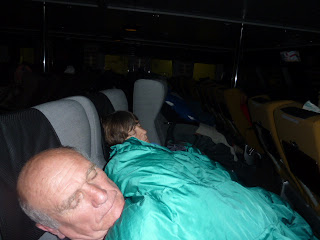We set out on the scenic coast route, then decided the poor weather was giving us no return on viewing, so detoured back to the faster main road. Ended up wasting most of our day and arrived quite late in Halifax
Visited the excellent Maritime museum, with history of Halifax, including the 1917 explosion, Titanic exhibit, Gays on boats, and tons of other very interesting stuff. Pouring rain! We rushed/sloshed our way from the Museum to the Neptune theatre to see "Frankenstein" - competently produced, but the story line did not appeal to us.
Then to the Old Triangle Irish pub downtown & Alexander Keith beer(s). A group of six sat around a table in the corner and sang, played guitar, mandolin, Irish drum and fiddle. Low key but very beautiful - a huge pleasure after the Celtic rock that had assailed us in our other musical expeditions. The pub emptied, but we stayed late & applauded them.
We slept in comfort on a Halifax street
The next morning, we got back to a Wendy priority, and visited a wool shop to replenish supplies. Wonderful Fleece Artist kits of mixed yarns in fabulous colours - irresistible. Forgot about all the wool I have at home :-)

Next to the National Museum of Immigration at Pier 21 - boat on the left is the Empress of Canada which first brought Richard to Quebec from Liverpool third class in 1957. On the right, the Queen Mary which first brought Wendy (first class!) to Canada via New York in 1951. Many artifacts and stories relating to 2.5 million immigrants, mainly from Europe. Easy to re-envisage our first arrivals in Canada
On the right is the HMCS corvette Sackville which did 4 years convoy duty in the N. Atlantic during WWII. The bridge is fully exposed, just in front of the mast. Weather was cold and strong winds blowing gave lots of atmosphere on the boat and made us want to re-read "The Cruel Sea"
We also went on board the SS Arcadia (right) - a vessel that was used for hydrographical surveys on the E Coast & Hudson Bay for 50 years. Also it was armed and used in defense of Halifax during WWII We were only allowed on the main deck - not below because Hurricane Ophelia was creating too much wind & danger.
Then to a lobster dinner at the Bluenose restaurant, before joining dancers in Dartmouth (across the harbour from Halifax) for English Country Dancing - pretty tame compared to Scottish Dancers. Apparently, many of the group do the English CD after being invalided out of SCD!
By amazing co-incidence, one of the dancers was one of the group of six players and singers we had so enjoyed in the pub the previous night & he recognized us. He said we must go back to the Old Triangle same pub with him after dancing 'cos a great group - The Dirty Dogs - were playing. So back we went for more beer(s) and some great music!
Wendy hob-nobbing with the Dirty Dog Fiddler. One of his ancestors was Italian & I think he, like Paganini, has made a pact with the devil because only a fiend can fiddle as fast as he can!
We invested in one of their CD's so that others can share that exhilarating music

Us with Leo, the dancer and musician - he spends half the year in Halifax and half in his home, Boston. Lovely guy.
We slept again in quiet and comfort on the streets of Halifax.
Despite the continuing bitter wind, it was not raining - or not much - so we braved the Citadel - high on the hill in the centre of Halifax. Spent several hours there hearing about the defences and battles prepared for and seeing all the various equipment, guns and kinds of ammunition, and displays documenting the history. In this photo, the demo was of the firing of the cannon - a daily event, tourists or not. Wendy never wants to go to another fort.
Very cold winds.
 Just beyond Peggy's cove, another monument that of course we stopped at and read. It was a solemn recognition of Swissair 111 which came down in 1998, 10 km offshore. Local people came to the rescue - as much as possible. A beautiful spot that was hazy in the rain.
Just beyond Peggy's cove, another monument that of course we stopped at and read. It was a solemn recognition of Swissair 111 which came down in 1998, 10 km offshore. Local people came to the rescue - as much as possible. A beautiful spot that was hazy in the rain.Next morning, in Mahone Bay, found a lovely little cafe and while Richard worked on the computer - 4 hours - I wandered in the village and to another yarn shop and again was unable to resist a different collection of Fleece Artist yarns. Oh well....
The cafe was also a book shop and, since it was a converted house, there were 3 comfortable rooms for sitting, eating and reading.























































